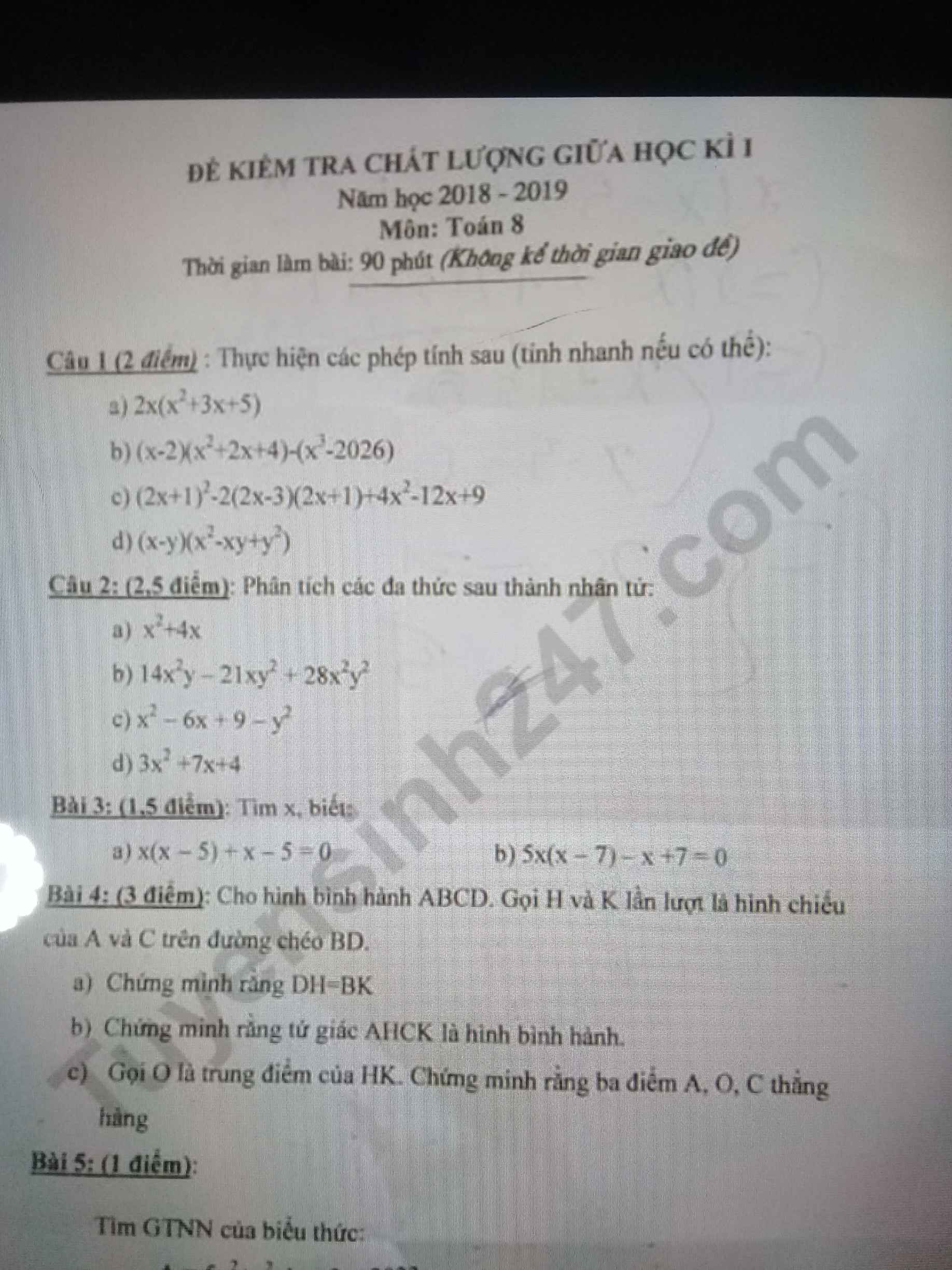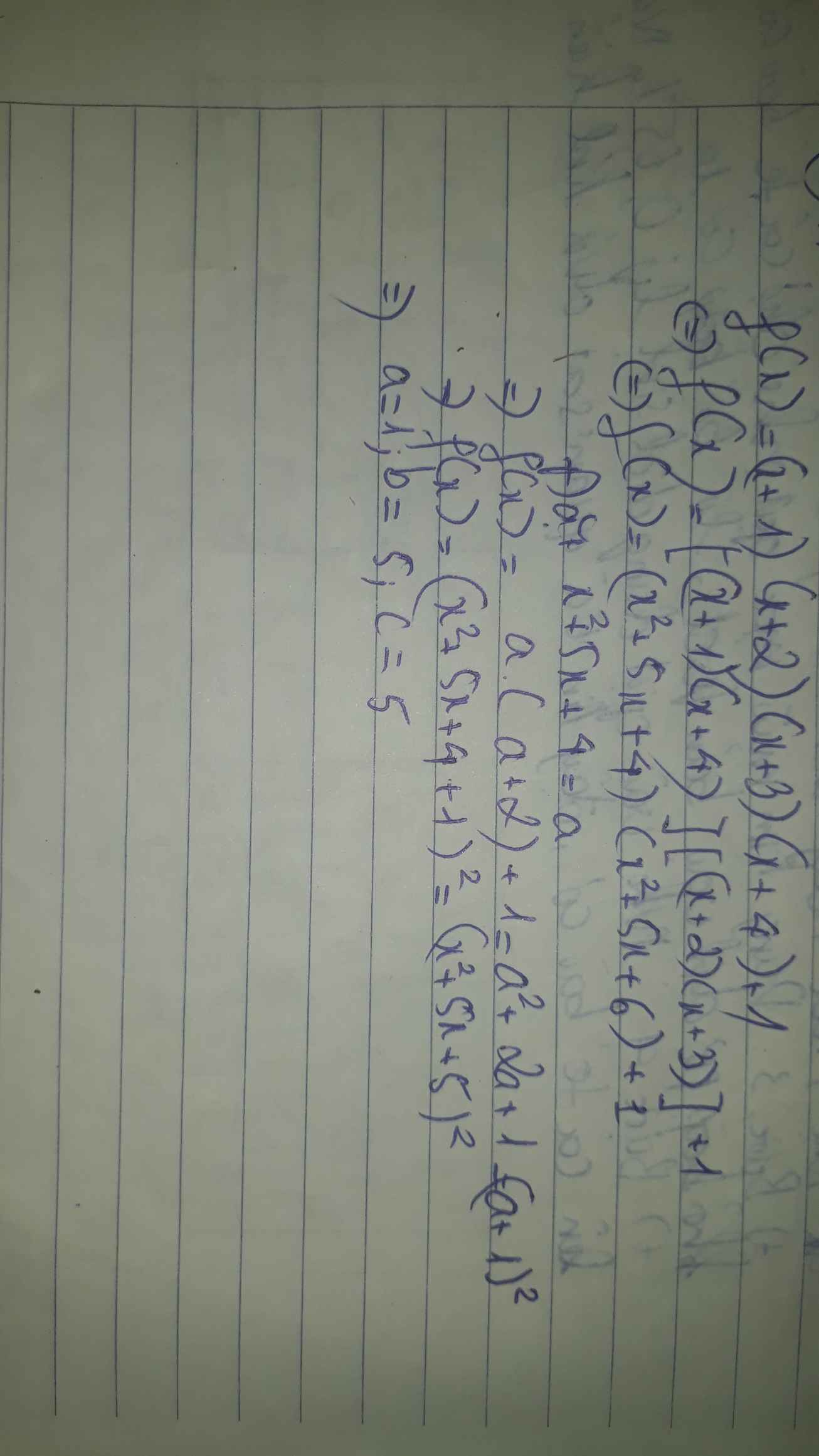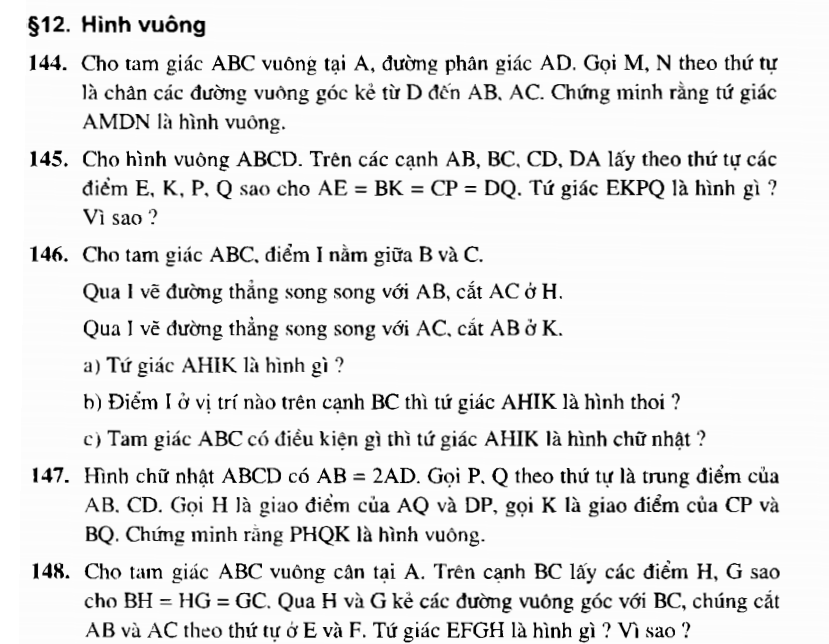
Hãy nhập câu hỏi của bạn vào đây, nếu là tài khoản VIP, bạn sẽ được ưu tiên trả lời.


2: \(A=x^2-10x+25-34=\left(x-5\right)^2-34\ge-34\forall x\)
Dấu '=' xảu ra khi x=5
\(1,C=x^2+x-3\\ \Rightarrow C=\left(x^2+x+\dfrac{1}{4}\right)-\dfrac{13}{4}\\ \Rightarrow C=\left(x+\dfrac{1}{2}\right)^2-\dfrac{13}{4}\ge-\dfrac{13}{4}\)
dấu "=" xảy ra \(\Leftrightarrow x=-\dfrac{1}{2}\)
Vậy \(C_{min}=-\dfrac{13}{4}\Leftrightarrow x=-\dfrac{1}{2}\)
\(2,A=x^2-10x-9\\ \Rightarrow A=\left(x^2-10x+25\right)-34\\ \Rightarrow A=\left(x-5\right)^2-34\)
dấu "=" xảy ra \(\Leftrightarrow x=5\)
Vậy \(A_{min}=-34\Leftrightarrow x=5\)

Lời giải:
$A=11-5x-x^2=11-(x^2+5x)=17,25-(x^2+5x+2,5^2)=17,25-(x+2,5)^2$
Vì $(x+2,5)^2\geq 0$ với mọi $x$ nên $A=17,25-(x+2,5)^2\leq 17,25$
Vậy $A_{\max}=17,25$ khi $x+2,5=0\Leftrightarrow x=-2,5$

3: Ta có: \(\left(x+3\right)\left(x^2-3x+9\right)-x\left(x-1\right)\left(x+1\right)=27\)
\(\Leftrightarrow x^3-27-x^3+x=27\)
hay x=54

Xét tứ giác ABCD có
\(\widehat{A}+\widehat{B}+\widehat{C}+\widehat{D}=360^0\)
\(\Leftrightarrow2\cdot\left(\widehat{A}+\widehat{D}\right)=360^0\)
\(\Leftrightarrow\widehat{A}+\widehat{D}=180^0\)
mà hai góc này là hai góc ở vị trí trong cùng phía
nên AB//CD
Xét tứ giác ABCD có AB//CD
nên ABCD là hình thang
mà \(\widehat{A}=\widehat{B}\)
nên ABCD là hình thang cân

- Ta có:
\(f\left(x\right)=\left(x+1\right)\left(x+2\right)\left(x+3\right)\left(x+4\right)+1\)
\(=\left(x+1\right)\left(x+4\right)\left(x+2\right)\left(x+3\right)+1\)
\(=\left(x^2+5x+4\right)\left(x^2+5x+6\right)+1\)
Đặt: \(\left(x^2+5x+5\right)=a\) ta được:
\(=\left(a-1\right)\left(a+1\right)+1\)
\(=a^2-1+1=a^2\)
Thay lại \(a=\left(x^2+5x+5\right)\) được:
\(\left(x^2+5x+5\right)^2\)
- Đối chiếu với \(\left(ax^2+bx+c\right)^2\)
Vậy \(a=1;b=5;c=5\)


XXét tứ giác AMDN có ^AMD=^MAN=^AND=90∞
⇒AMDN là hình chữ nhật
hcn AMDN có AD là phân giác góc A
⇒AMDN là hình vuông(dấu hiệu 3)

B,
Hạng tử \(x^4\) : hệ số \(1\) , phần biến \(x^4\) ; Bậc : \(4\)
Hạng tử \(-4x^3y\) : hệ số \(-4\) ; phần biến : \(x^3y\) ; Bậc \(4\)
Hạng tử \(6x^2y\) : hệ số \(6\) ; phần biến : \(x^2y\) ; Bậc : \(3\)
Hạng tử \(-4xy\) : hệ số \(-4\) ; phần biến : \(xy\) ; bậc \(2\)
Hạng tử \(y\) : hệ số \(1\) ; phần biến : \(y\) ; bậc 1
C,
Hạng tử \(2023x^{2024}y^{2025}\) : hệ số \(2023\) ; phần biến \(x^{2024}y^{2025}\) ; bậc : \(4049\)
Hạng tử \(-\dfrac{1}{2026}yz^{2027}\) : hệ số \(-\dfrac{1}{2026}\) ; phần biến : \(yz^{2027}\) ; bậc : \(2028\)








a) đkxđ: \(x\ne\pm2\)
Ta có: \(\frac{x+2}{x-2}-\frac{x-2}{x+2}=\frac{4}{x^2-4}\)
\(\Leftrightarrow\frac{\left(x+2\right)^2-\left(x-2\right)^2}{\left(x-2\right)\left(x+2\right)}=\frac{4}{\left(x-2\right)\left(x+2\right)}\)
\(\Rightarrow8x=4\)\(\Rightarrow x=\frac{1}{2}\)
b) đkxđ: \(x\ne\left\{1;-3\right\}\)
PT \(\Leftrightarrow\frac{\left(x+1\right)\left(x+3\right)-\left(x+2\right)\left(x-1\right)+4}{\left(x-1\right)\left(x+3\right)}=0\)
\(\Rightarrow x^2+4x+3-x^2-x+2+4=0\)
\(\Leftrightarrow3x+10=0\Rightarrow x=-\frac{10}{3}\)
c) đkxđ: \(x\ne\left\{0;-1\right\}\)
\(PT\Leftrightarrow\frac{\left(x-1\right)\left(x+1\right)+1-2x}{x\left(x+1\right)}=\frac{x}{x\left(x+1\right)}\)
\(\Rightarrow x^2-1+1-2x=x\)
\(\Leftrightarrow x^2-3x=0\)
\(\Leftrightarrow\orbr{\begin{cases}x=0\left(ktm\right)\\x=3\left(tm\right)\end{cases}}\)
d) đkxđ: \(x\ne\left\{1;5\right\}\)
\(PT\Leftrightarrow\frac{x-1-3}{\left(x-1\right)\left(x-5\right)}=\frac{5\left(x-5\right)}{\left(x-1\right)\left(x-5\right)}\)
\(\Rightarrow x-4=5x-25\)
\(\Leftrightarrow4x=21\Rightarrow x=\frac{21}{4}\)
e) đkxđ: \(x\ne\left\{0;-2;2\right\}\)
\(PT\Leftrightarrow\frac{-2x+x+2}{x\left(x-2\right)\left(x+2\right)}=\frac{\left(x-4\right)\left(x-2\right)}{x\left(x-2\right)\left(x+2\right)}\)
\(\Rightarrow-x+2=x^2-6x+8\)
\(\Leftrightarrow x^2-5x+6=0\Leftrightarrow\left(x-2\right)\left(x-3\right)=0\Rightarrow\orbr{\begin{cases}x=2\\x=3\end{cases}}\)